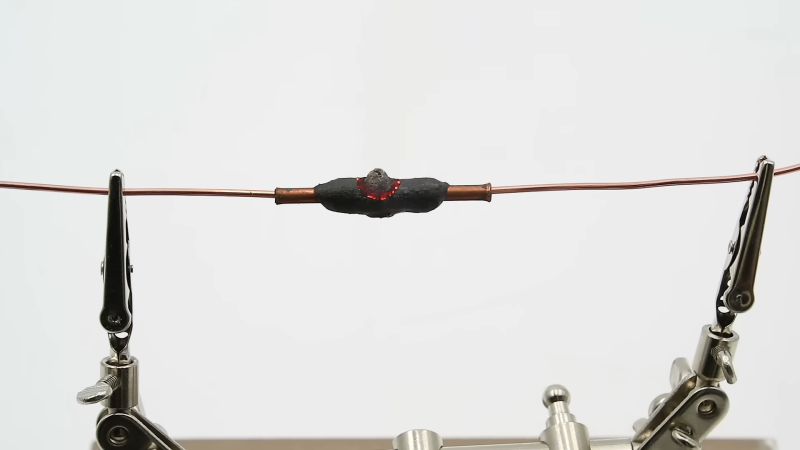Imagine you’re a commando, doing some big secret mission on the continent in the midst of World War II. You need to hook up some wires to your explosive charges, and time is of the essence. Do you bust out the trusty Weller and see if those petulant Axis chaps will let you plug it in somewhere? No! You use a pyrotechnic self-soldering sleeve, as [Our Own Devices] explains.
Like so many British inventions during the war, the sleeves really are ingenious. They were developed by the Special Operation Executive, an organization charged with sabotage and subversion operations in then-occupied Europe.
The soldering sleeves were designed to make electrical connections between detonators and firing wires for explosives. The sleeves consist of a copper tube through which wires to be joined are fed, with a lump of solder in the middle. The assembly is covered in pyrotechnic material with a safety match-style starter chemical dosed on top. Using the sleeves is simple. First, two stripped wires are fed into either end of the copper tube. The starter the sleeve is then ignited using the box, just like striking a match. The pyrotechnic material then gets red hot, melting the solder and making the connection.
It’s well worth watching the video to see how these field-expedient devices actually work. We’ve explored the use of more-typical solder sleeves before, too. Video after the break.

















I’d probably just twist the wires up, but then again I don’t have to worry about watching twenty of my compatriots waltz into a machine gun nest if it gets pulled loose.
We were taught to twist the wires, bend them, shove them into a plastic sleeve containing petroleum jell and bend the sleeve making it a water proofconnection. No smell, no fire etc.
Safety fuses were lit using a special technique and normal/waterproof matches.
I like that better than these “sleeves” which do not sound reliable to me (old-time electronics man)
Pyrotechnics would have been far more fun than the crimp B-Wire connectors from Western Electric used by regional Bell companies.
https://thumbs.worthpoint.com/zoom/images2/1/0816/15/vintage-western-electric-telephone_1_178ac874bd1b40dc6057bf40f7e898ae.jpg
Admittedly, you can fit a lot more if you’re doing a lot of connections but, for a small number, the bulk and mass of the crimping tool makes that less portable.
Seems like a wire nut would have done. Another situation of zero gravity space pen vs. pencil?
at least wire nuts still work if you get them wet.
Would a wire nut do as well on a wire in tension or one that might get tugged on?
Solder is not glue!
Soldered joints create a sharp stress concentration point that is extremely unreliable under “tugging”. Wire nuts, on the other hand, generally create a bend with a relatively large radius, and if sized right and applied properly are more reliable. They certainly are quicker as well. I base all of that upon having done at least a thousand of each.
Just guessing, but this seems like it would make a waterproof connection with high pull-strength. Being able to withstand seawater submersion and very rough handling was probably a requirement
Normally, when doing sabotage or “plain” demolition, high pull strength is not a requirement. Submersion into e.g. seawater is circumvented using petroleum jelly filled plastic tubes (probably not available back then).
But what do I know? Ex. Army EOD amongst other things ;-)
Petroleum jelly is pretty old so they would have had it. But since you’re an Ex EOD. You know how to wire demolition, but what if you’re a dummy in the resistance who has never seen explosives before and now you’re actually planting and wiring them, would this self soldering sleeve be easier to use than how you, as a trained EOD, would make the connection?
The reason pencils were not a good fit? They use graphite, which is highly conductive, both electrically and thermally, is brittle, and is encased in wood, which is flammable – not a good fit for an oxygen rich environment with a lot of electronics.
The cosmonauts used grease pencils on plastic blackboards, but switched to the Fisher Pen Company’s “Space Pen” in 1969 – a short two years after NASA started using them (the Soviet space program got the same commercial discount given to NASA)
Prof. Poliakoff from PeriodicVideos presented the very same device about 5 years ago: https://youtu.be/rXZscASelkc?t=165 and in much less “I’m a youtuber” fashion too.
Yes, but does he pay for exposure? The HaD linked channel is obviously produced – there is no other way to research and make two videos a week.
HaD probably doesn’t make enough on ads and I didn’t look into how the linked channel gets it’s funding for production but it’s probably not youtube video monetization.
Better than DuPont connectors. :(
I spoke to my grandfather many years ago about WW2, as he served in the pacific. He didn’t talk a lot about *things* relating to WW2, but I remember him talking specifically about THESE connectors and how they were absolute crap. He explained how the *match head part* was often damaged, as the individual connctors were all stored together in the box, and rattled around, boucing off each other in there for a long time (months? Years?)… He talked about them breaking apart when you tried to strike them (I imagine as some of us know from poorly stored matches from years ago..), and how the tiny “copper pipes” (his words, they may or may not be copper) were often bent and too small to get the wire ends into. I wonder if it was just his experience, or if they were disliked by everyone?